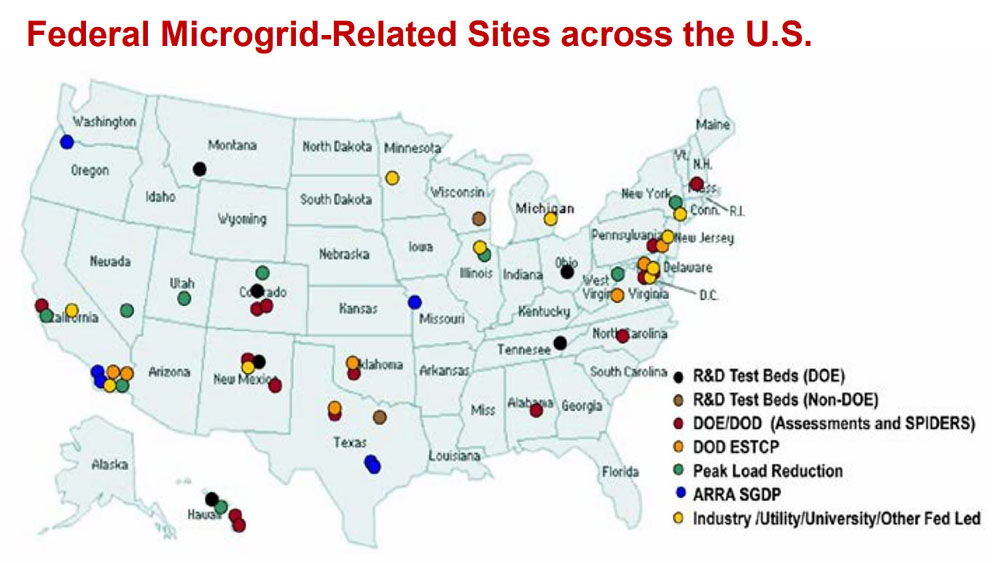Toward something “cleaner, leaner, smarter, more customized and more secure” is where the electricity system needs to go, said Anne Pramaggiore, President and CEO of ComEd in her keynote address at the International District Energy Association’s November 2016 microgrid conference. To get there, utilities will need to transition from a “pipeline model” to a “platforms model.”
 Illustration from a presentation by Robert Beaton, Primus Power.
Toward that end, microgrids are smaller in scale and localized and so allow for “low-risk, high-upside” experimentation to allow for development of new techniques for increased system resilience, integration of distributed energy resources and the like.
Illustration from a presentation by Robert Beaton, Primus Power.
Toward that end, microgrids are smaller in scale and localized and so allow for “low-risk, high-upside” experimentation to allow for development of new techniques for increased system resilience, integration of distributed energy resources and the like.
We are in a revolution, she emphasized. It’s reinventing the way we work, communicate, socialize, shop and live. The mass-production model of the early 20th century needed the efficiencies from economies of scale and the financial predictability of regulation. Now, by a technological tsunami, we are returning to a more decentralized system. Economies of scale are being traded for economies of scope and consumer choice.
The grid of the 20th century enabled all the other innovations of that century, she said, leading us to the point where artificial intelligence and robotics will transform the economy once more.
Some have been suggesting that, in this emerging world, the grid itself is becoming obsolete, overtaken by a totally disconnected and discrete system. But the grid will become more powerful, not less. It’s the power of networks, she said, citing University of California Berkeley Professor Carl Shapiro: “There is a central difference between the old and new economies: the old industrial economy was driven by economies of scale; the new information economy is driven by the economics of networks.”
A single home with its own power array and a battery in the basement is a powerful idea, but it’s more powerful still as part of a network that enhances choice, efficiencies and opportunities.
In transitioning from a pipeline to a platforms model, utilities have been growing in a way that allows taking advantage of these network effects. Platforms are now the dominant business model of our time. The electric grid has the potential to become the most important platform in the economy.
Utilities will need to continue to deliver the same core responsibilities – affordable, reliable power – only now it has to allow more sources to interact on the grid.
According to Lloyd’s of London, a cyber-attack on just one region of the United States could cost in the hundreds of millions of dollars. A smarter, automated and flexible grid could make all the difference. Microgrids are a part of that flexibility, at a minimum, by protecting critical areas like police, hospitals and emergency response centres. The advantages grow with microgrid clusters, as ComEd would like to do in the Bronzeville neighborhood on the south side of Chicago. The proposed Bronzeville microgrid would connect to another on the Illinois Tech campus, by way of a ComEd-designed controller. Photovoltaics and battery storage are to be added in 2018. Further additions will include smart streetlights that can be remotely dimmed and brightened, and can self-report if they are out of power. Electric car service is planned as a mobility solution, and in the process, studying drivers’ charging patterns.
Microgrids can also serve as test beds for new technologies and new electric ecosystem concepts. They can create new social infrastructure for communities of the future. In Bronzeville, local engineering talent is being given the opportunity to do the design work.
Microgrids meet us where we are, Ms. Pramaggiore said, adapting to neighborhood preferences and lifestyles. There will be no one-size-fits-all solutions to designing the cities of the future.
She noted Silicon Valley’s mantra for how to innovate: Move fast and break things. But utilities, which build systems with half-century lifespans, can’t do it that way. Microgrids can bridge the gap between reliability and innovation. Commonwealth Edison, commonly known as ComEd, is the largest electric utility in Illinois.
Summarized from a presentation by Anne Pramaggiore at IDEA’s Microgrid conference. Presentations and selected video clips from the conference are available at www.districtenergy.org/events/conferences and select Microgrid 2017, or here.
